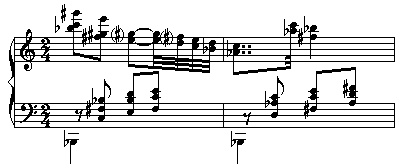The whole-tone scale consists entirely of whole steps. It is a hexatonic (six-tone) scale; that is, six steps are required to fill in the octave.
The whole-tone scale has no modes because each rotation of the pitches produces an identical pattern of steps and intervals.
Example 1: Whole-tone Scale
Only one transposition, up a minor second, produces a new collection of pitches.
Example 2: Whole-tone Scale transposed
Unless one uses double sharps or flats, it is difficult to avoid a diminished third when writing a whole tone passage.
Example 3: Diminished thirds in whole-tone passages.
Debussy based Violes (Prelude # for Piano) on the whole tone scale. The following example faithfully reproduces a passage from that work. Notice how he handled the problem of the diminished third, not always consistently.
Example 4: Violes (from Preludes for Piano)
Pattern Repetition in the whole-tone scale is especially pronounced. For example, every second and third is major, every fourth is a tritone, and every sixth and seventh is minor. All triads are augmented. Any pattern built on one step of the scale can be replicated on all other steps of the scale
Example 5: Pattern Repetition
A keynote or central pitch is established by persistance rather than by use of context forming intervals. There are no perfect fourths or fifths to help create harmonic focus. The major third, the next strongest root producing interval, lies above every step making every step a potential keynote. Furthermore, the augmented triad divides the octave into three equal segments. Any of its tones can be perceived as the root of the chord. One usually hears the lowest tone in the texture as the root of the chord because it is the root of the lowest major third.
Example 6: Roots in Augmented Triads
If the tritone is spelled enharmonically as a diminished fifth, all tones of the scale can be use to build a dominant ninth chord with (1) a lowered fifth and an added minor thirteen or (2) a raised fifth and and augmented eleventh. The latter can also be seen as a polychord of two augmented triads. These chords can be produced on every step of the scale. The harmonic potential of the scale centers on the sound of a complex altered dominant chord.
Example 7: (1) Dominant ninth (-5, -13) (2) Dominant ninth (+5, +11)
A whole-tone chord can be constructed from a collection of scale steps. For example, steps 1-2-3-4 will produce an dominant ninth chord. Steps 1-2-4-5 will produce an altered dominant seventh. The number of possible patterns is limited if one eliminates all duplications produced by transposition. A little experimentation with this method will show that all chords produced by the step method are subsets of the chords in Example 6.
Example 8: Chord Construction by Scale Step Pattern
Bartok's Mikrokosmo 136 (Volume V), Whole-tone Scale illustrates several writing techniques effectively adapted to whole-tone materials. In m.m. 1-19, Bartok used pedal tones to establish pitch centers. A short canon begins at m. 20. The remainder of the piece (m.m. 28-80) features a variety of devices such as simultaneous use of the scale and its transposition, parallelism, polychords and mirror lines.
Griffes White Peacock. whole tone passing chords provide a melodic linkage in a passage of complex chords.
Example 9: Whole-tone Chords in Griffes' White Peacock

Because latent pattern repetition, extended whole-tone passages are difficult to sustain. For the sake of interest, one should consider increased use of texture, timbre, rhythm and other variables such as transposition. While full of redundancy, the whole tone scale also produces vivid and memorable colors, making its use an effective diversion.
The whole-tone scale contains a few memorable thematic protocells that can be replicated on every step of the scale. 1-3-4 is the melodic inversion of 1-2-4. 1-2-3-4 and 1-2-4-5 are identical to their melodic inversions; that is, they map onto themselves.
Example 11: Whole-tone thematic protocells
A rich panchromatic context is possible by combining a whole tone scale and its transposition. This, combined with use of recurring motives based on protocells, can produce coherent and colorful passages.
Example 12: Sample Whole-tone Passages

The whole-tone scale is one of the all-combinatorial hexachords listed by Milton Babbitt. This hexachord combined with its solitary transposition produces an aggregate (all twelve pitch classes). See materials on pitch sets and twelve-tone composition for further details.
Copyright © 1996, Kenneth R. Rumery, all rights reserved. Revised May 9, 1996.